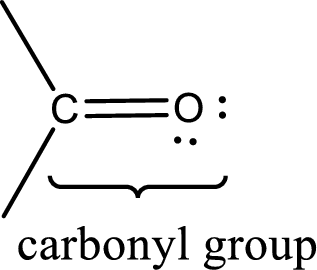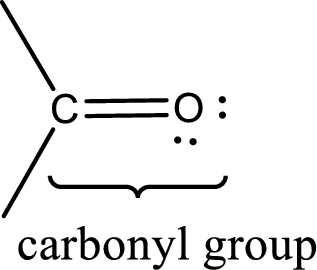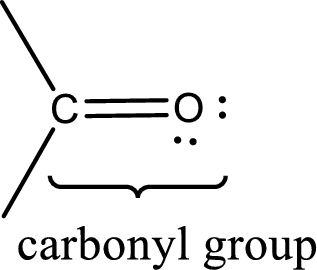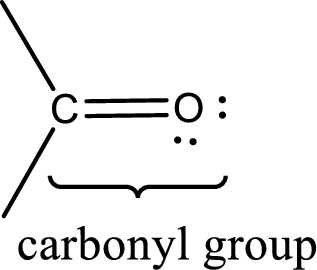
(a)
Interpretation:
Aldehyde must contain the element nitrogen or not has to be indicated.
Concept Introduction:
Carbonyl groups are the one which contain a double bond between carbon and oxygen atom.

The groups that is attached to the carbonyl carbon atom can be either hydrogen or carbon atom. If the attached atoms are hydrogen and a carbon atom means then the compound is an aldehyde and if they are two carbon atoms means then the compound is a ketone. If the attached atom is a nitrogen atom to the carbonyl carbon atom means it is a amide. If a hydroxyl group is attached to a carbonyl carbon atom, then it is a
(b)
Interpretation:
Ketone must contain element nitrogen or not has to be indicated.
Concept Introduction:
Carbonyl groups are the one which contain a double bond between carbon and oxygen atom. Aldehydes and ketones possess this carbonyl functional group in it. The structural representation of a carbonyl group can be given as shown below,

The groups that is attached to the carbonyl carbon atom can be either hydrogen or carbon atom. If the attached atoms are hydrogen and a carbon atom means then the compound is an aldehyde and if they are two carbon atoms means then the compound is a ketone. If the attached atom is a nitrogen atom to the carbonyl carbon atom means it is a amide. If a hydroxyl group is attached to a carbonyl carbon atom, then it is a carboxylic acid. If one of the bond in the carbonyl carbon atom is attached to an oxygen atom that is bonded with alkyl, cycloalkyl or aromatic system is known as ester.
(c)
Interpretation:
Ester must contain element nitrogen or not has to be indicated.
Concept Introduction:
Carbonyl groups are the one which contain a double bond between carbon and oxygen atom. Aldehydes and ketones possess this carbonyl functional group in it. The structural representation of a carbonyl group can be given as shown below,

The groups that is attached to the carbonyl carbon atom can be either hydrogen or carbon atom. If the attached atoms are hydrogen and a carbon atom means then the compound is an aldehyde and if they are two carbon atoms means then the compound is a ketone. If the attached atom is a nitrogen atom to the carbonyl carbon atom means it is a amide. If a hydroxyl group is attached to a carbonyl carbon atom, then it is a carboxylic acid. If one of the bond in the carbonyl carbon atom is attached to an oxygen atom that is bonded with alkyl, cycloalkyl or aromatic system is known as ester.
(d)
Interpretation:
Amide must contain element nitrogen or not has to be indicated.
Concept Introduction:
Carbonyl groups are the one which contain a double bond between carbon and oxygen atom. Aldehydes and ketones possess this carbonyl functional group in it. The structural representation of a carbonyl group can be given as shown below,

The groups that is attached to the carbonyl carbon atom can be either hydrogen or carbon atom. If the attached atoms are hydrogen and a carbon atom means then the compound is an aldehyde and if they are two carbon atoms means then the compound is a ketone. If the attached atom is a nitrogen atom to the carbonyl carbon atom means it is a amide. If a hydroxyl group is attached to a carbonyl carbon atom, then it is a carboxylic acid. If one of the bond in the carbonyl carbon atom is attached to an oxygen atom that is bonded with alkyl, cycloalkyl or aromatic system is known as ester.
Want to see the full answer?
Check out a sample textbook solution
Chapter 15 Solutions
GENERAL,ORGANIC,+BIO.CHEM.-MINDTAP
- Rel. Intensity Q 1. Which one of the following is true of the compound whose mass spectrum is shown here? Explain how you decided. 100 a) It contains chlorine. b) It contains bromine. c) It contains neither chlorine nor bromine. 80- 60- 40- 20- 0.0 0.0 TT 40 80 120 160 m/z 2. Using the Table of IR Absorptions how could you distinguish between these two compounds in the IR? What absorbance would one compound have that the other compound does not? HO CIarrow_forwardIllustrate reaction mechanisms of alkenes with water in the presence of H2SO4, detailing each step of the process. Please show steps of processing. Please do both, I will thumb up for sure #1 #3arrow_forwardDraw the following molecule: (Z)-1-chloro-1-butenearrow_forward
- Identify the molecule as having a(n) E, Z, cis, or trans configuration. CH3 H₁₂C ○ E ○ z ○ cis transarrow_forwardIdentify the molecule as having a(n) E, Z, cis, or trans configuration. H₂C- CH3 О Е ○ cis ○ transarrow_forwardThe decomposition of dinitrogen pentoxide according to the equation: 50°C 2 N2O5(g) 4 NO2(g) + O2(g) follows first-order kinetics with a rate constant of 0.0065 s-1. If the initial concentration of N2O5 is 0.275 M, determine: the final concentration of N2O5 after 180 seconds. ...arrow_forward
- Don't used hand raitingarrow_forwardCS2(g) →CS(g) + S(g) The rate law is Rate = k[CS2] where k = 1.6 × 10−6 s−¹. S What is the concentration of CS2 after 5 hours if the initial concentration is 0.25 M?arrow_forwardCS2(g) → CS(g) + S(g) The rate law is Rate = k [CS2] where k = 1.6 × 10-6 s−1. S Calculate the half-life.arrow_forward
- The following is a first order reaction where the rate constant, k, is 6.29 x 10-3 min-*** What is the half-life? C2H4 C2H2 + H2arrow_forwardControl Chart Drawing Assignment The table below provides the number of alignment errors observed during the final inspection of a certain model of airplane. Calculate the central, upper, and lower control limits for the c-chart and draw the chart precisely on the graph sheet provided (based on 3-sigma limits). Your chart should include a line for each of the control limits (UCL, CL, and LCL) and the points for each observation. Number the x-axis 1 through 25 and evenly space the numbering for the y-axis. Connect the points by drawing a line as well. Label each line drawn. Airplane Number Number of alignment errors 201 7 202 6 203 6 204 7 205 4 206 7 207 8 208 12 209 9 210 9 211 8 212 5 213 5 214 9 215 8 216 15 217 6 218 4 219 13 220 7 221 8 222 15 223 6 224 6 225 10arrow_forwardCollagen is used to date artifacts. It has a rate constant = 1.20 x 10-4 /years. What is the half life of collagen?arrow_forward
 Organic And Biological ChemistryChemistryISBN:9781305081079Author:STOKER, H. Stephen (howard Stephen)Publisher:Cengage Learning,
Organic And Biological ChemistryChemistryISBN:9781305081079Author:STOKER, H. Stephen (howard Stephen)Publisher:Cengage Learning, General, Organic, and Biological ChemistryChemistryISBN:9781285853918Author:H. Stephen StokerPublisher:Cengage LearningChemistry: Matter and ChangeChemistryISBN:9780078746376Author:Dinah Zike, Laurel Dingrando, Nicholas Hainen, Cheryl WistromPublisher:Glencoe/McGraw-Hill School Pub Co
General, Organic, and Biological ChemistryChemistryISBN:9781285853918Author:H. Stephen StokerPublisher:Cengage LearningChemistry: Matter and ChangeChemistryISBN:9780078746376Author:Dinah Zike, Laurel Dingrando, Nicholas Hainen, Cheryl WistromPublisher:Glencoe/McGraw-Hill School Pub Co
 World of Chemistry, 3rd editionChemistryISBN:9781133109655Author:Steven S. Zumdahl, Susan L. Zumdahl, Donald J. DeCostePublisher:Brooks / Cole / Cengage Learning
World of Chemistry, 3rd editionChemistryISBN:9781133109655Author:Steven S. Zumdahl, Susan L. Zumdahl, Donald J. DeCostePublisher:Brooks / Cole / Cengage Learning Chemistry: The Molecular ScienceChemistryISBN:9781285199047Author:John W. Moore, Conrad L. StanitskiPublisher:Cengage Learning
Chemistry: The Molecular ScienceChemistryISBN:9781285199047Author:John W. Moore, Conrad L. StanitskiPublisher:Cengage Learning





